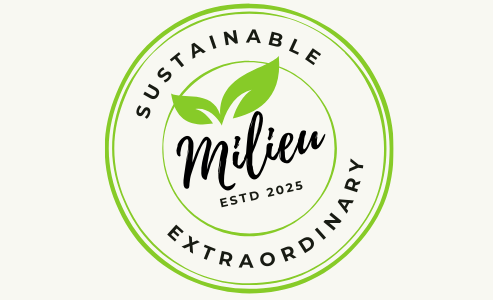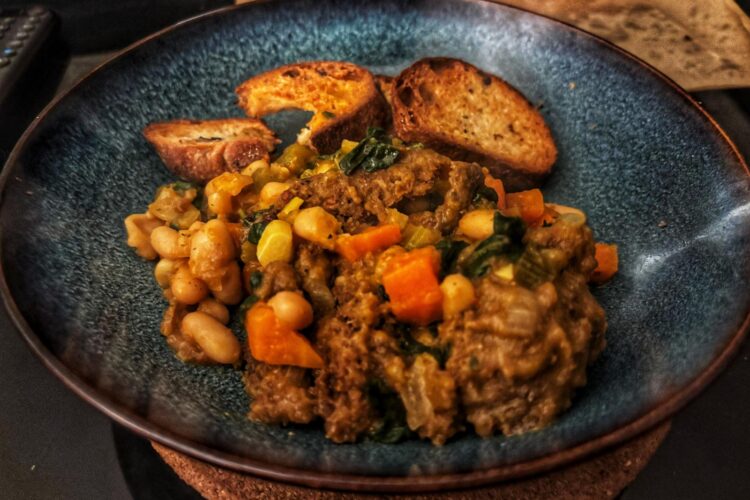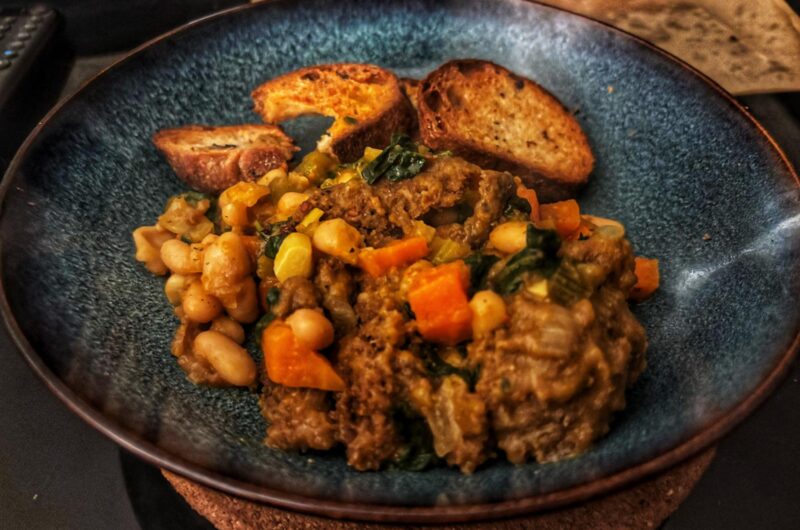A vegetable and bean-filled, protein-packed, antioxidant-rich soup perfect for a hearty family dinner
Ribollita is a classic Tuscan soup. This soup will comfort you and your family on those long and cold winter nights.
Itialian cuisine: A background
One of the most beloved cuisines in the world is Italian. When we think of Italian cuisine, soups aren’t usually the first thing that come to mind. Instead, our imagination is often filled with cheese-laden pastas and pizzas; dishes that, at first glance, might not seem nutrient-rich. However, did you know that Italian cuisine, especially the traditional Mediterranean diet, is considered one of the healthiest in the world?
Mediterranean cuisine, the backbone of Italian cooking, has long been recognized as one of the healthiest diets in the world. It is rich in plant-based ingredients, healthy fats, and simple cooking techniques that preserve nutrition. In fact, many of the regions classified as ‘Blue Zones’, where people live the longest and healthiest lives, follow some form of Mediterranean diet.
Very much like the Indian classic, Baingan ka Bharta which was featured in the last post, Ribollita is a staple dish amongst the Tuscan agrarian communities. Fresh, simple ingredients shine to create a hearty, soul-warming and filling dishes, like Ribollita.
Why is this special?
Why am I, an Indian origin home cook, so passionate about Ribollita?
- Those who know me, know that I am obsessed with fresh ingredients and healthy living. I give my heart and soul to researching and writing about healthy, plant-based eating practices.
- Indian cuisine goes beyond butter chicken and naan. I come from a region and community in India known for making simple ingredients shine. Filled with healthy cooking techniques and healthy eating habits prescribed by an ancient Indian science called ayurveda, my family has ensured that every dish we eat had a component of goodness along with taste.
Why use this Ribollita recipe?
Should you seek out a recipe from a Tuscan grandmother instead?
Of course! But I’ve done my research, testing this recipe countless times and tasting versions made by Tuscan cooks. Therefore, I can confidently say that this one delivers on flavor and authenticity.
However, by all means, I encourage you all to share authentic takes. In fact, if you find your roots in the Tuscan region, do share your thoughts and variations on the recipe in the comments section below.
Now, let’s get back to the recipe and what what goes in it.
What goes in a Ribollita
It is meant to use the humble leftovers in your refrigerator. It uses the protein-packed but humble navy (cannellini) bean as the star. You then need some kale leaves (can be easily substituted for spinach or mixed greens such as cavolo nero, Swiss chard or radish/turnip leaves), some tomato paste, veggie broth and a soffritto base made of carrots, celery and white onions. Leftover herbs like thyme, rosemary and even dried herbs like mixed herbs or oregano add a beautiful complexity. The one herb I insist on having is bay leaves. If you can’t find fresh ones, I still highly recommend using dried bay leaves.
White cooking wine helps to deglaze and bring everything together (cooking wine is usually non-alcoholic and even if you but alcoholic versions of white wine, it cooks off in the heat, posing no risk at all for pregnant women. However, for religious or personal reasons, if you prefer not to use wine, I would suggest using balsamic vinegar for deglazing). Add a chili or red chili flakes for spice (optional) and you have all the ingredients for your Ribollita.
The traditional recipe uses parmesan rind to add flavour to the soup. However, as most of you know, Parmigiano Reggiano is not a vegetarian cheese. Therefore, I have come up with a substitute for the rind.
What to do instead?
This recipe advocates the use of 1/2 tsp of nutritional yeast and 1 tbsp of ground cashews and pistachios to get the same effect. If you want to go nut-free, feel free to skip this by all means. I have made the recipe several times without the nuts and it turns out just fine.
And before you ask, I have tried making the recipe using rinds from veggie parmesan (Waitrose & Partners) and vegan parmesan. It does not provide the creamy, nutty effect that Tuscan nonnas swear by.
Now that we’ve covered the origins, the ingredients, and the secrets to maximizing flavor, let’s get cooking!
Ribollita Recipe: A step-by-step guide
Start by chopping vegetables for the soffritto base.
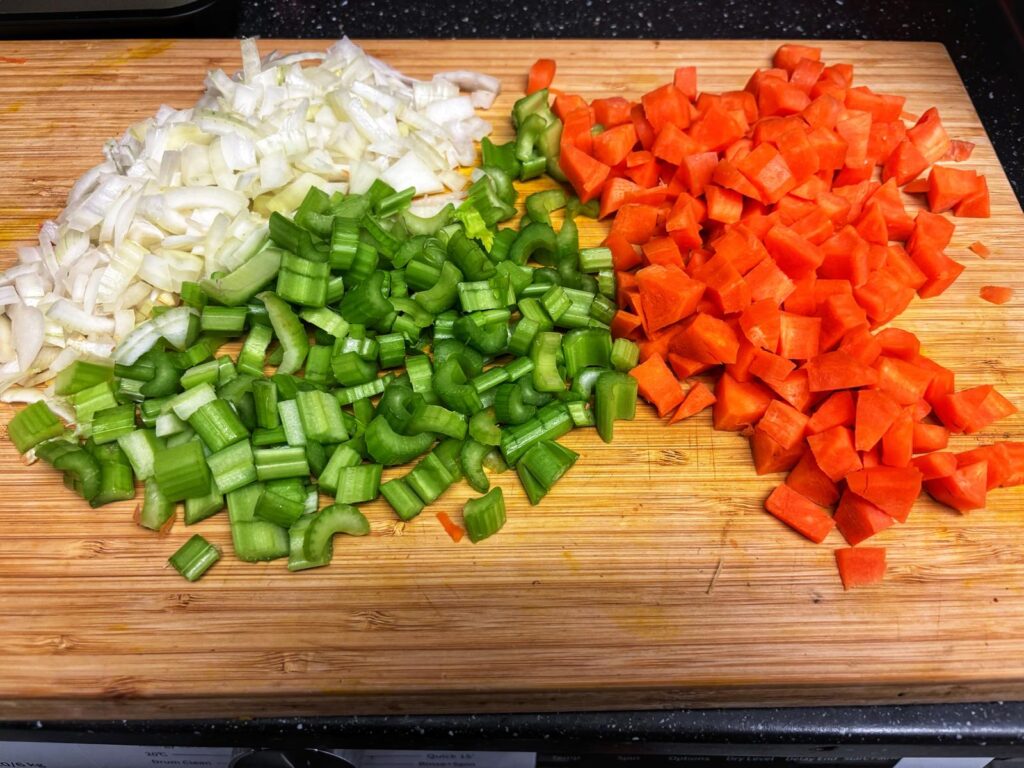
Heat a pan with 3 tbsp olive oil. Add 2 bay leaves and one sprig of rosemary. Also add the chopped vegetables. Sauté for 15-20 minutes.
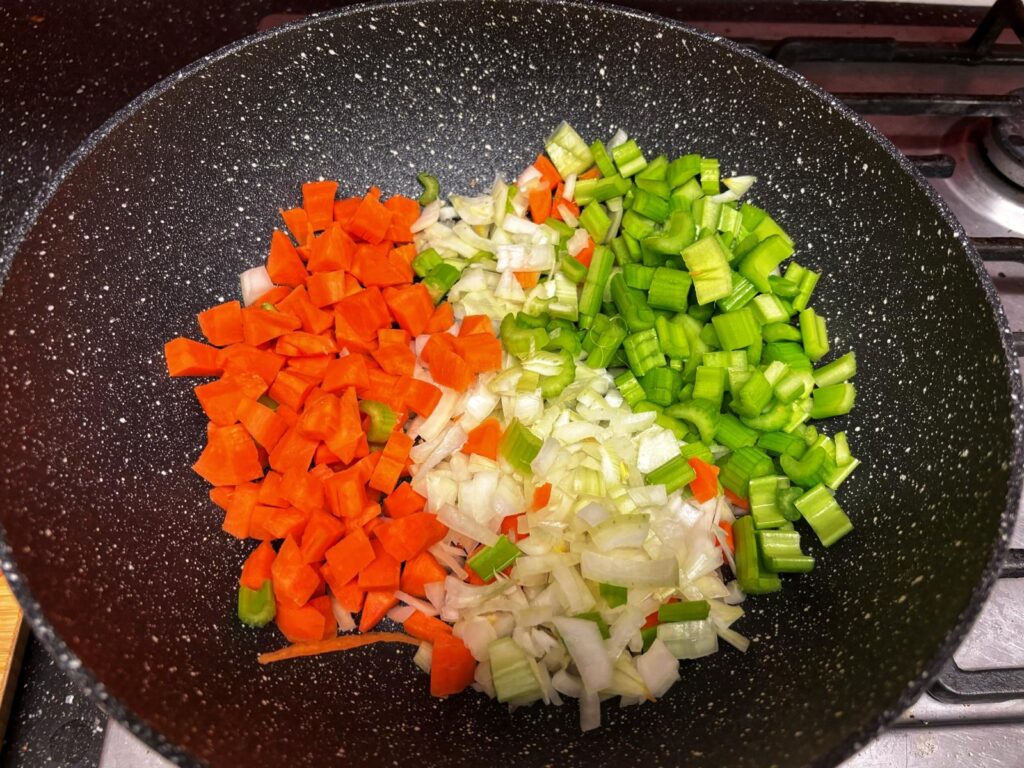
Add chopped garlic and cook till all the vegetables soften. Make sure that the vegetables don’t burn or brown.
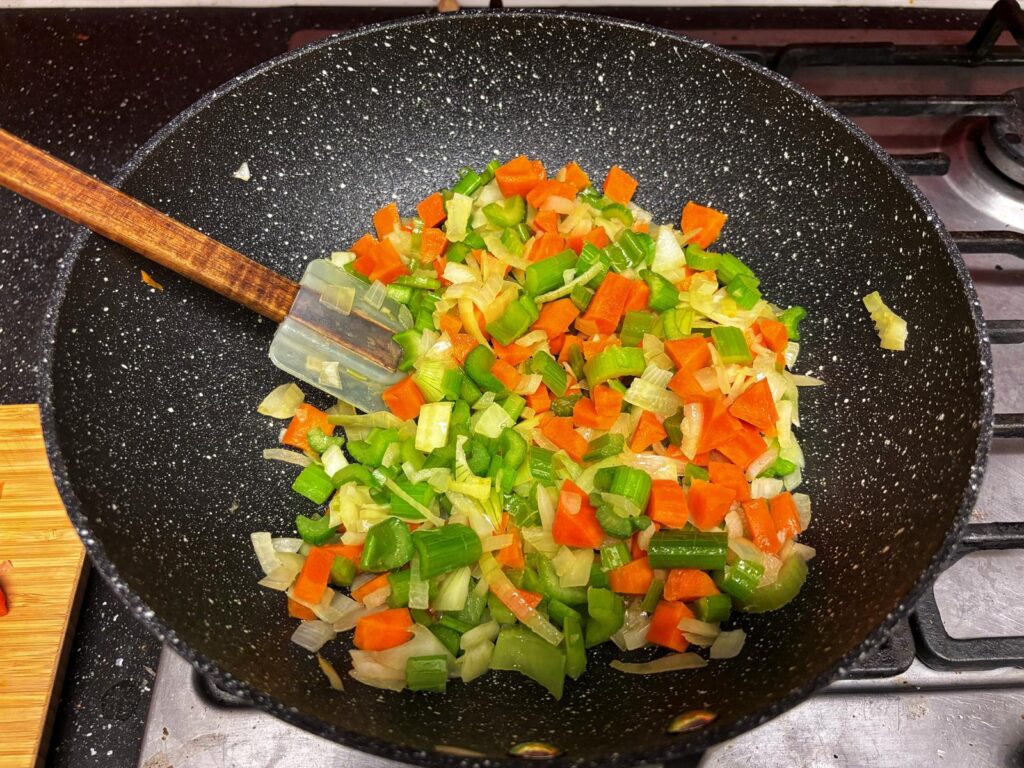
Add the seasonings & spices
Now add red chili flakes, dried mixed herbs, concentrated tomato paste, veggie stock powder and white wine. Cook till there is no alcohol left. Add a cup of water.
Now, Add beans
Then add the cannellini beans. Let this simmer for 15 mins.
Take a cup full of the mixture and blend it into a smooth paste. Add this to the soup. This would ensure that you have a creamy consistency.

Mix well. Adjust water for consistency and add salt to taste.
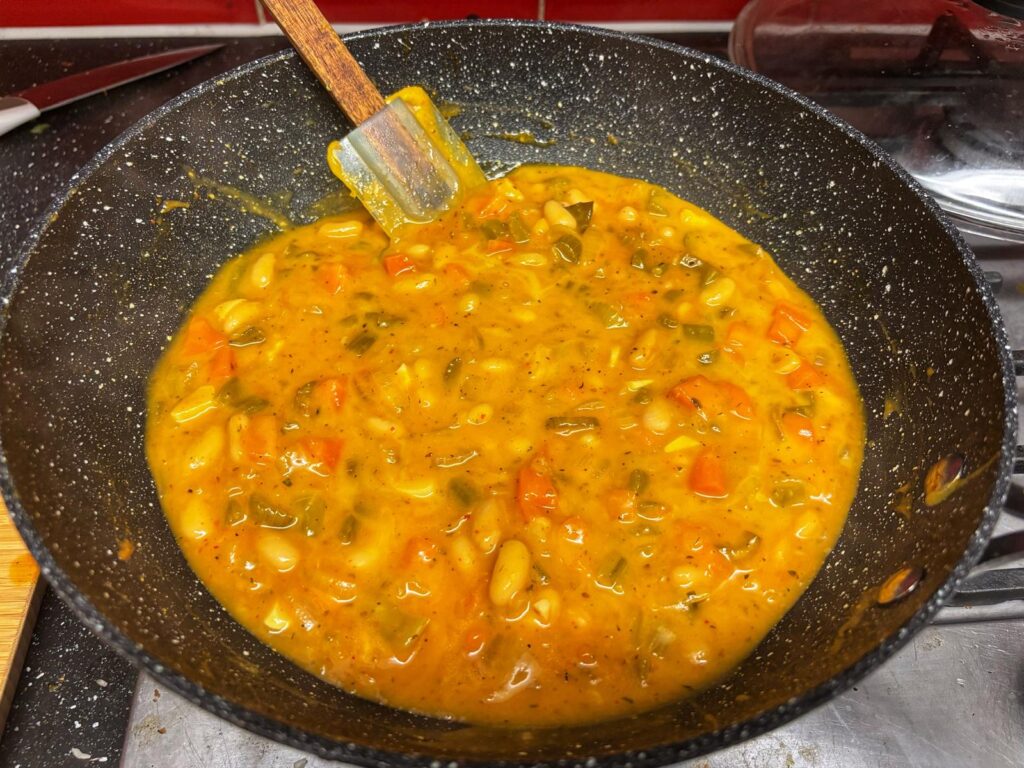
Bring it all together
Add the chopped greens. In this recipe I have used spinach. Cover and cook for 7-8 minutes. Cavolo Nero is tough and would require 18 minutes to cook. Greens like kale and Swiss chard would take 15 minutes.
Pro tip: Be sure to remove the central stalks from the cavolo nero. They are incredibly tough and take very long to cook. Also, you can boil kale or cavolo nero for 10 minutes and then let it simmer for 5-7 minutes in the soup.
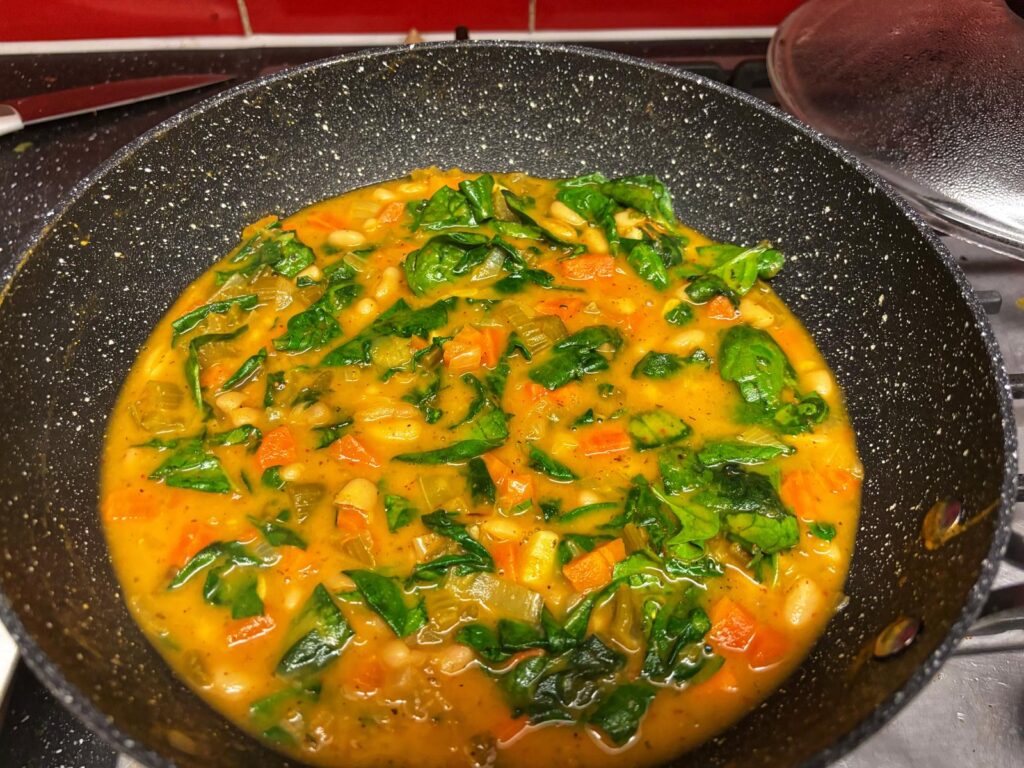
Pre-heat the oven to 180 degree Celsius. Toast the bread for 10 minutes (or till it becomes crisp and lightly golden). The traditional recipe uses Tuscan bread which makes for an incredibly creamy soup. However, I like to use hearty breads like multigrain sourdough or rye sourdough.
Add 70% of the toasted bread to the soup. Reserve the balance 30% to serve on the plate – it makes for a crunchy addition to the soup.
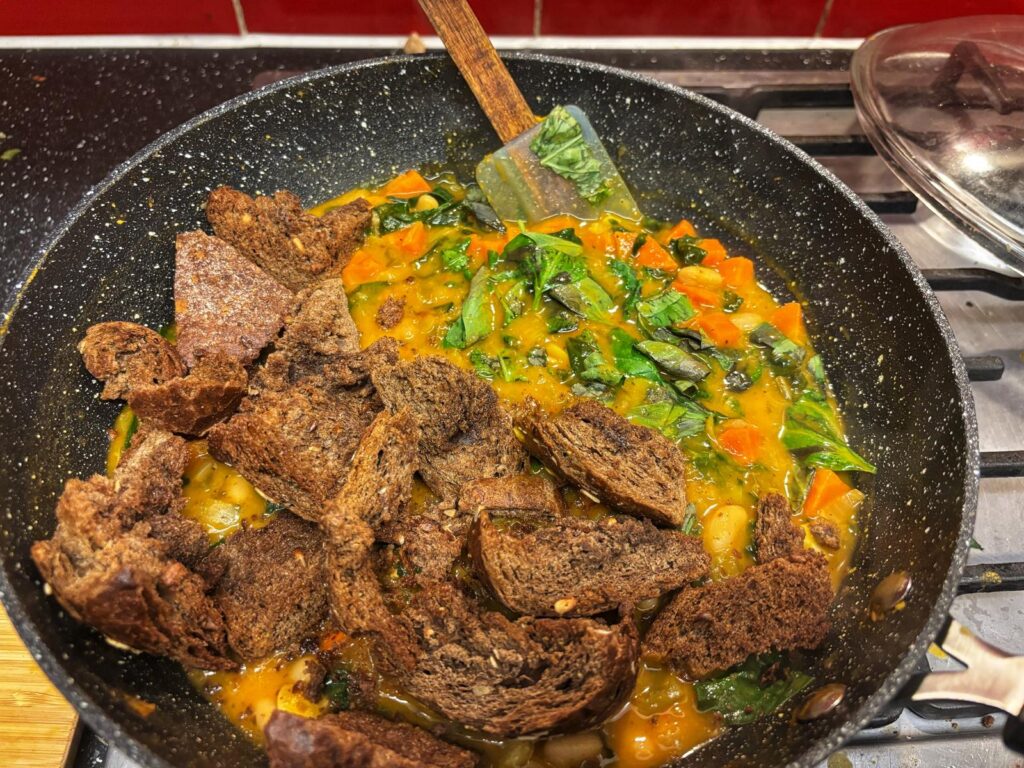
Garnish with chopped parsley, torn basil leaves and a squeeze of lemon juice.

Serve hot.
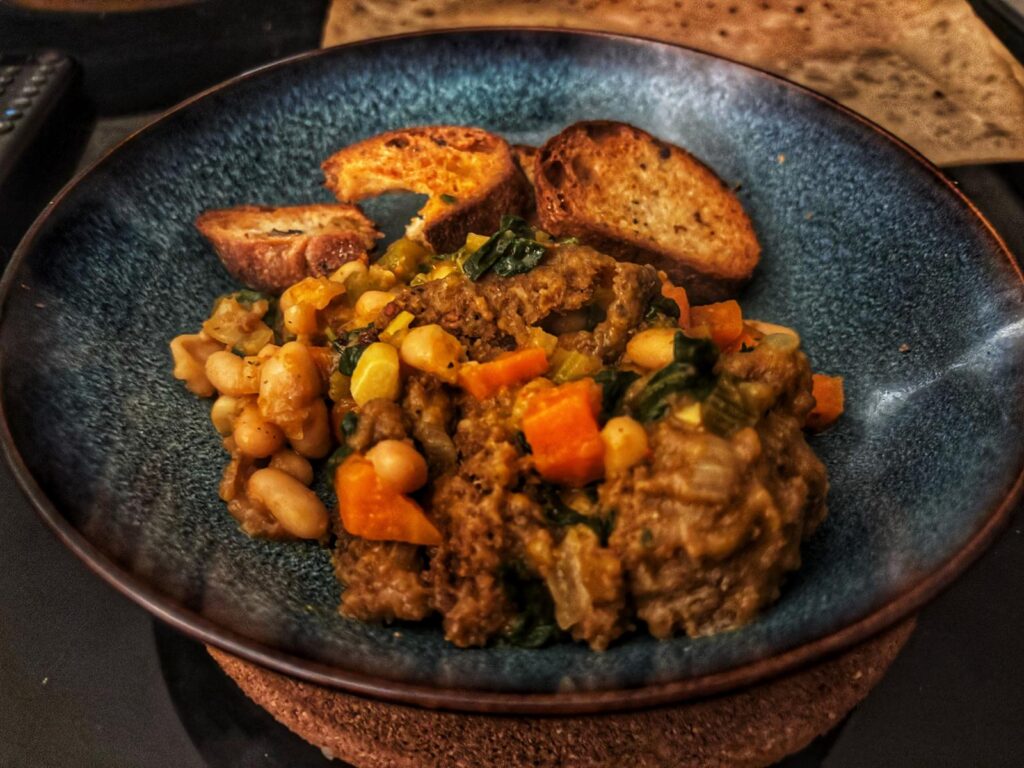
Ribollita | A Tuscan classic fall bean soup
Course: Main, SoupCuisine: Italian, TuscanDifficulty: Medium4
servings10
minutes50
minutes350
kcalIngredients
- For the soffritto base
1 large white onion, finely chopped
3 celery stalks, chopped
1 large carrot (or 3 baby carrots), chopped
1 sprig fresh rosemary (can substitute with dried mixed herbs)
2 dried bay leaves
3 tbsp extra virgin olive oil
- For the soup
1/2 cup white wine
2 tsp concentrated Italian tomato paste
400 g canned cannellini beans (also known as navy beans)
75 g chopped greens (spinach or kale or cavolo nero or other greens of choice)
2 tbsp vegetarian stock powder
1 tsp red chili flakes
Salt, to taste
- Toppings and Garnishing
2 g toasted stale bread (I like to use hearty breads like a rye sourdough)
1 tbsp chopped parsley
1 tsp dried oregano
1/2 lemon (to squeeze juice)
Directions
- Making the soffritto base
- Add 3 tbsp olive oil to a pan. Once it heats, add the onions, carrots and celery along with rosemary and dried bay leaves.
- Sauté on a low flame for 20 minutes.
- Once the base turns soft, add sliced garlic.
- Sauté for 10 more minutes. Be careful to not brown or burn any of the vegetables.
- Preparing the soup
- Add the white wine to the soup and let it simmer till the alcohol cooks off. If you are using an alcohol-free version, cook till the soffritto smells neutral i.e. no sourness from the cooking wine.
- Add 1 cup water, vegetable stock powder, the concentrated tomato paste, chili flakes and the cannellini beans. Cover and let it simmer on a low flame for 15 minutes.
- Uncover the lid and turn off the flame. Take one cup of the soup mixture and let it cool. Blend the mixture until creamy and smooth and add this back to the soup.
- Adjust the soup consistency by adding water. Ensure that the consistency is not too thin or watery. Add salt to taste.
- Toasting the bread
- Pre-heat the oven to 180 degree Celsius.
- Tear the stale (1-day old) bread with olive oil. Tearing it into relatively larger chunks works best.
- Coat stale bread (1 day old) bread with olive oil and place the pieces on a baking tray.
- Toast for 10 mins. The bread will become toasty and crisp.
- Bringing it all together
- Now add the chopped greens and let it simmer on low-medium flame for 15 minutes (ideal for kale and Swiss chard). You can reduce the simmering to 5-7minutes if you are adding greens that cook quickly (spinach, radish/turnip leaves). You can simmer for 2-3 minutes longer if you are using cavolo nero.
- Remove the bay leaves and the sprig of rosemary so that it doesn’t end up on people’s plates. Ensure you do this as dried herbs can cause severe choking.
- Add 70% of the bread to the soup. Let it soak it in. Reserve 30% of the bread to add to the soup on the table.
- Garnish with parsley leaves and serve with a dash of lemon.
Notes
- While wine brings everything together and adds a richer taste, you can skip it to make the food compliant to any personal/religious beliefs.
- For pregnant women, the alcohol completely cooks off and is therefore safe. You can also use white cooking wine that naturally has extremely low alcohol content or alcohol-free white wine.
- Ribollita quite literally means re-boiling. This soup can be stored in an airtight container and boiled fresh. However, for the best results, please store any extra portions before adding the bread and garnishing the dish. While reheating, boil the soup over a pan, adjust for consistency using water and add toasted bread.
Love beans but fancy something quicker? Try out this Butter Bean Soup or this 15-minute curried kidney bean.
If you loved this classic Tuscan recipe, try it at home. As always, I would love to hear if you make any modifications or find an innovative pairing. Share your experience in the comments below!
